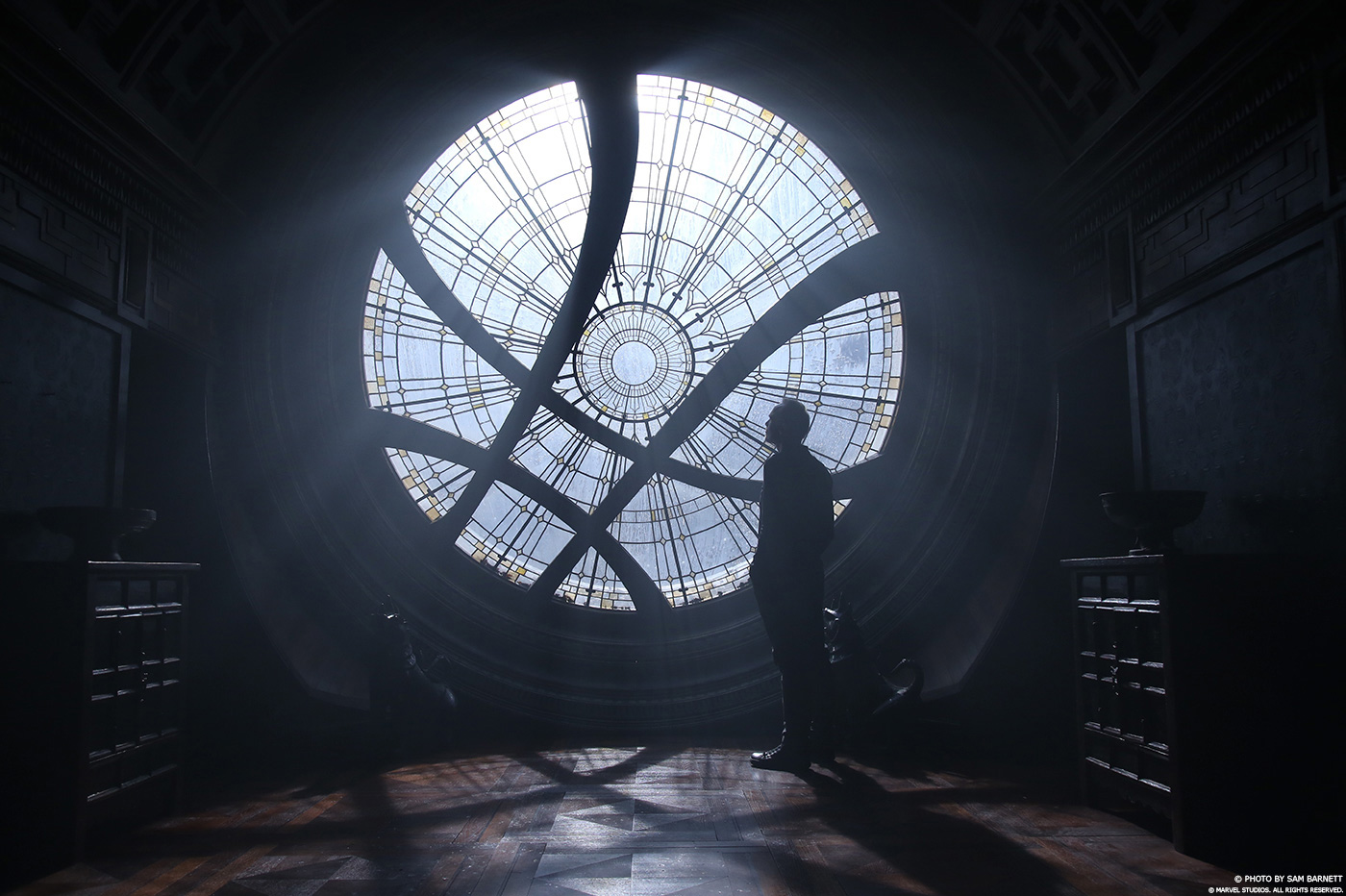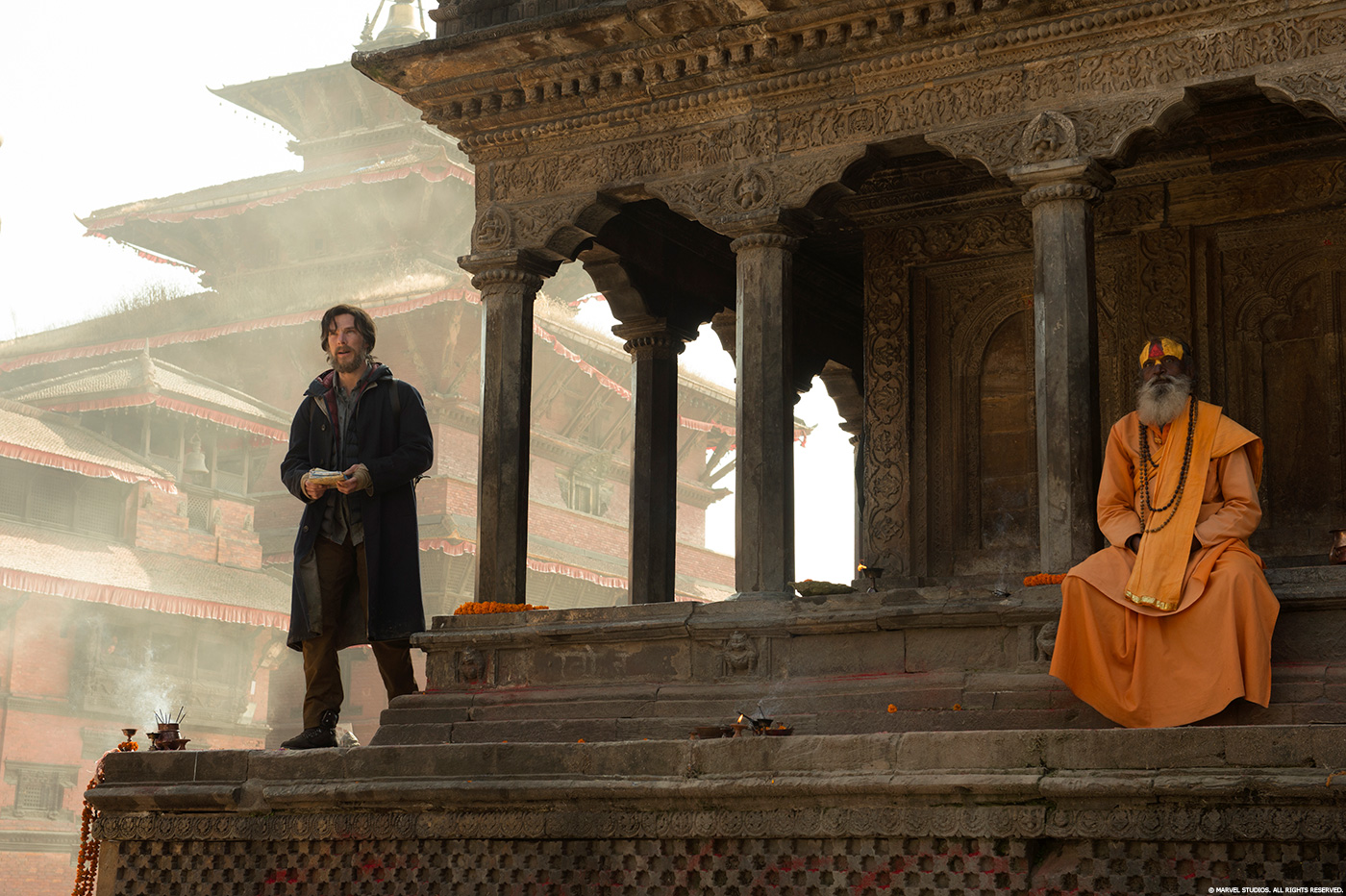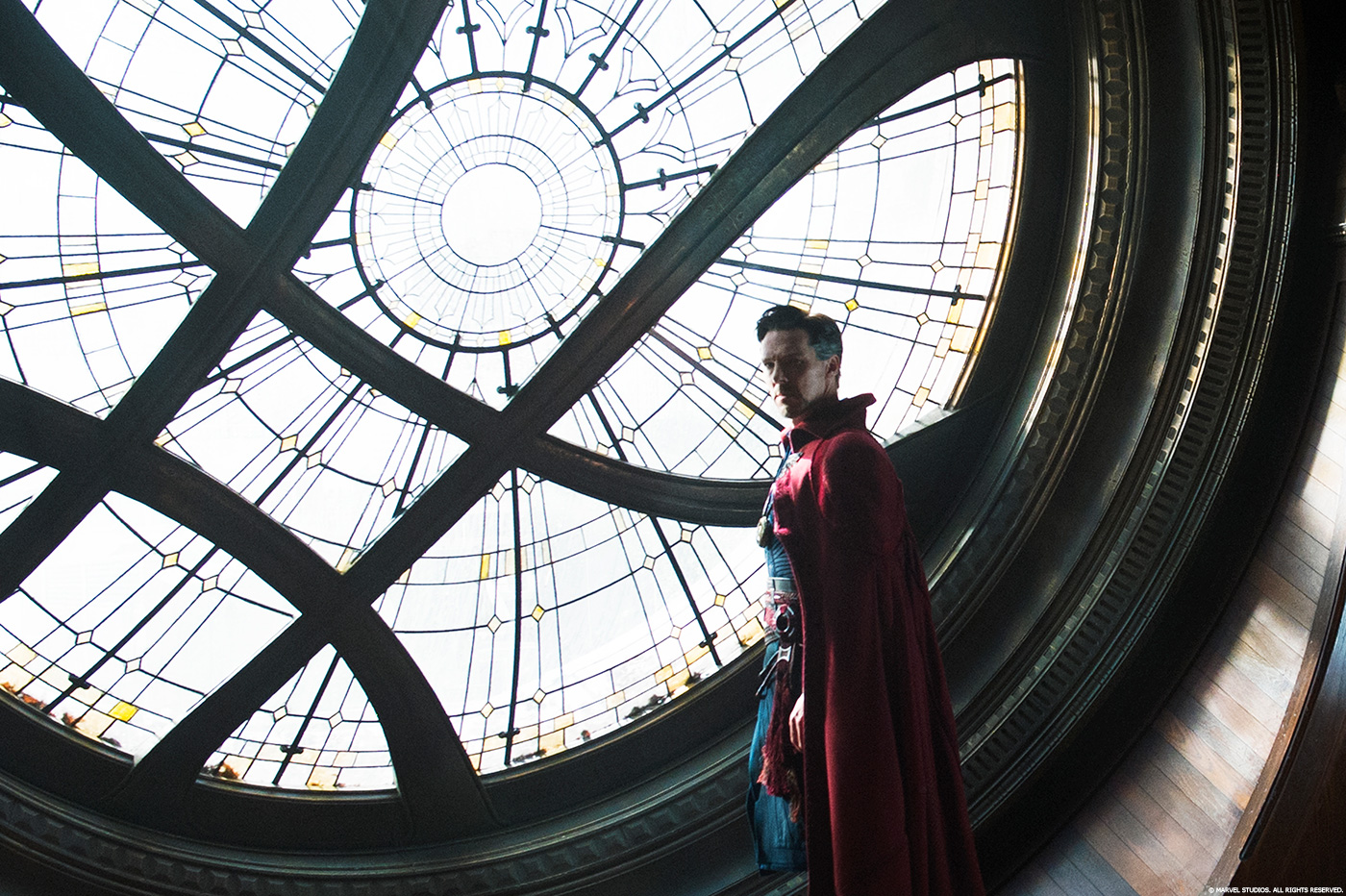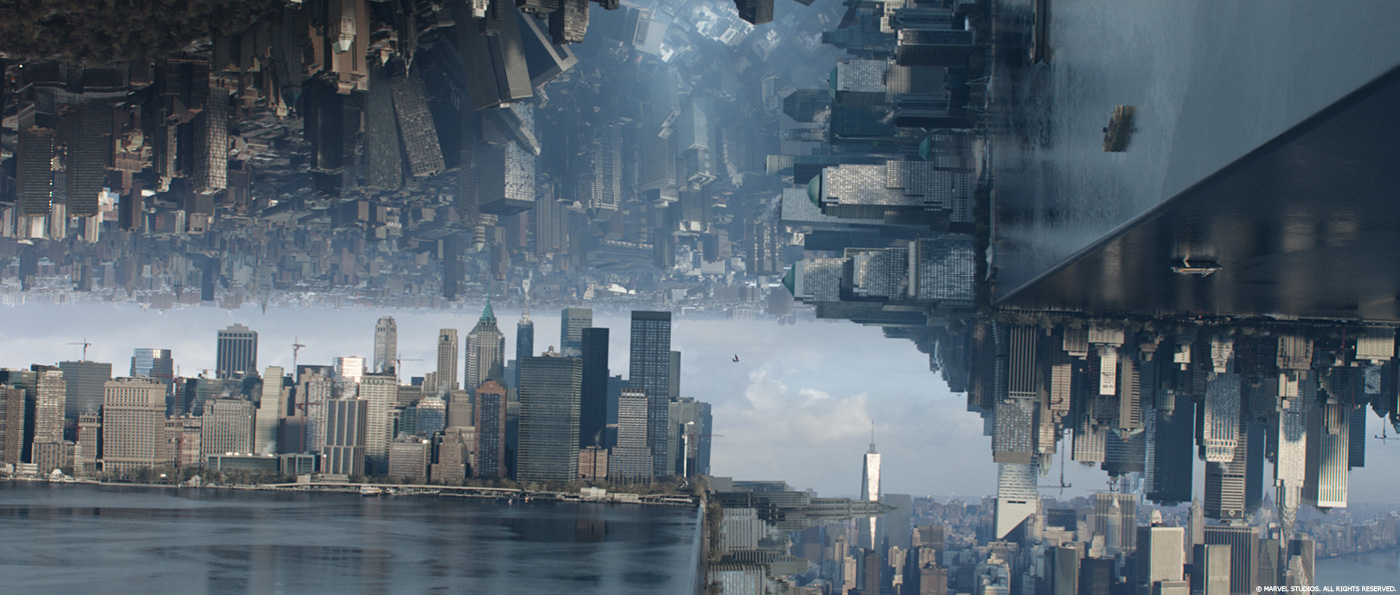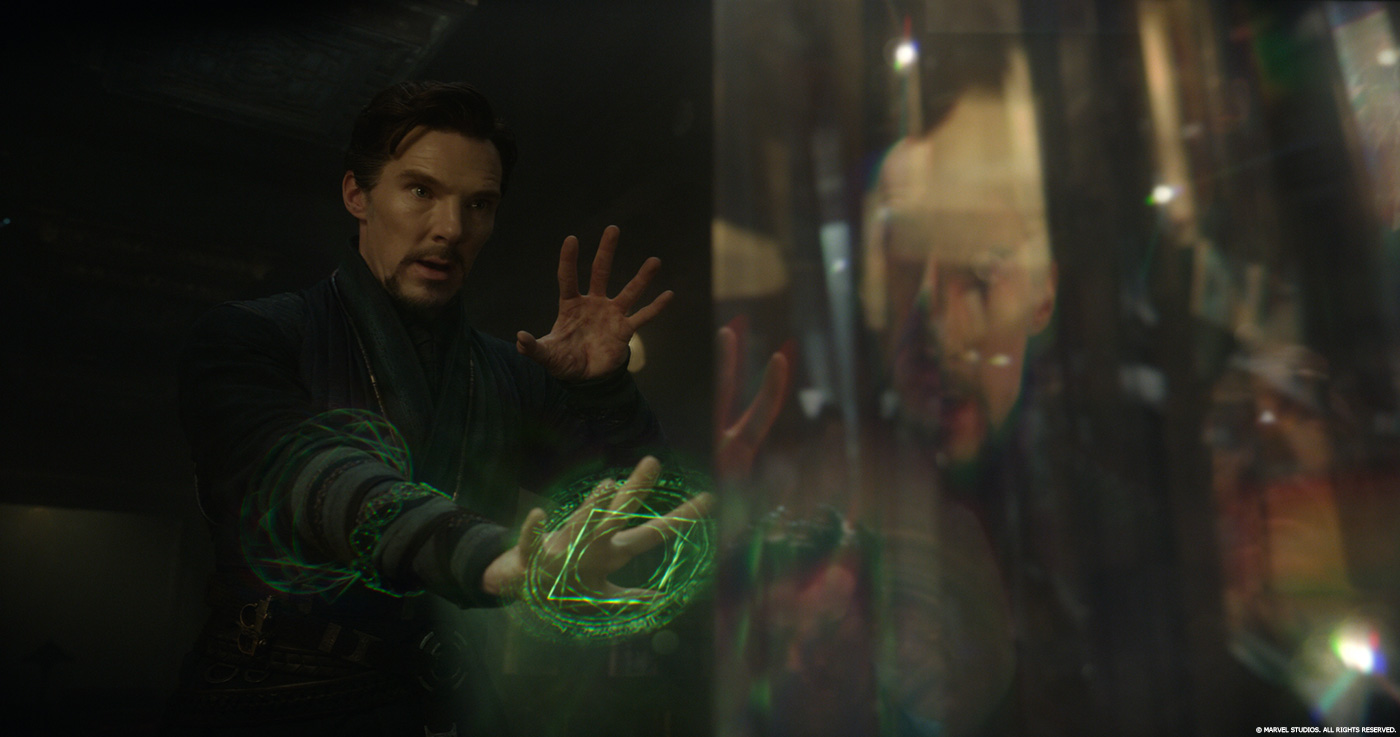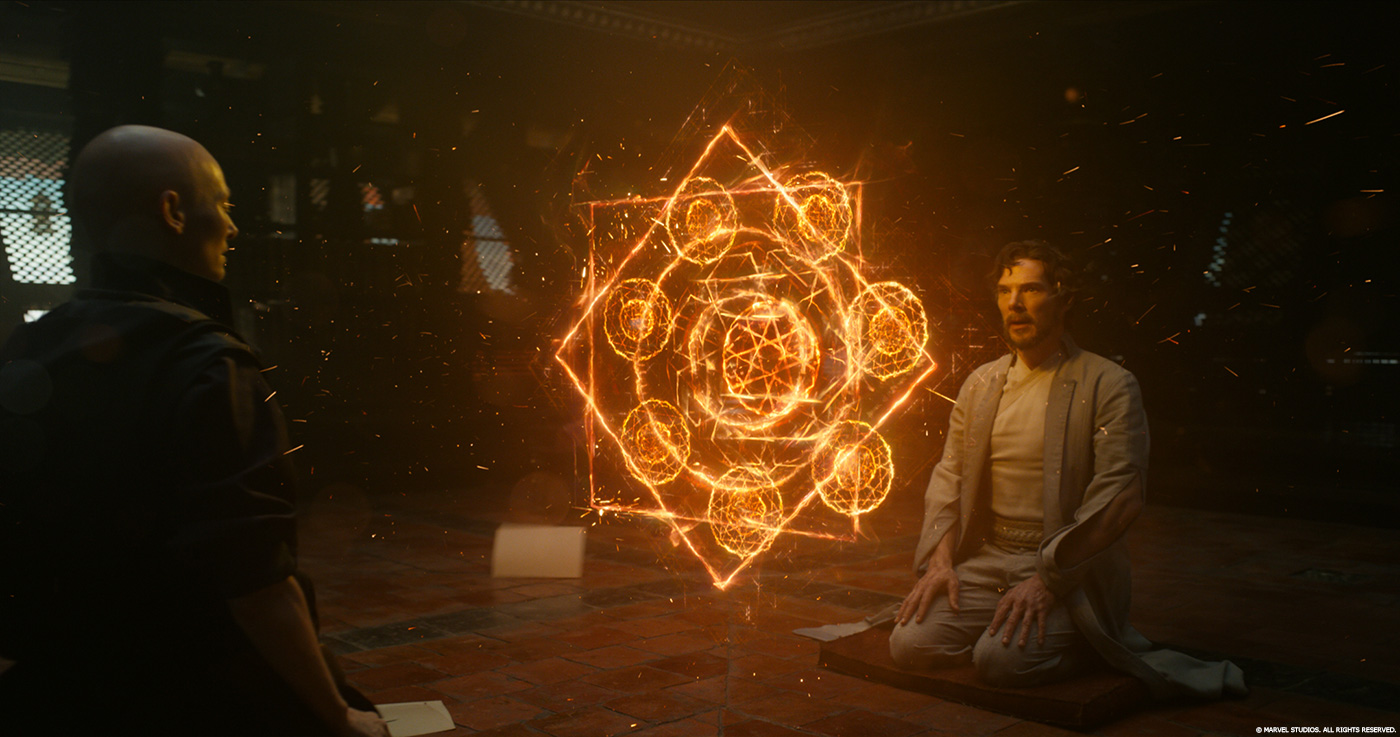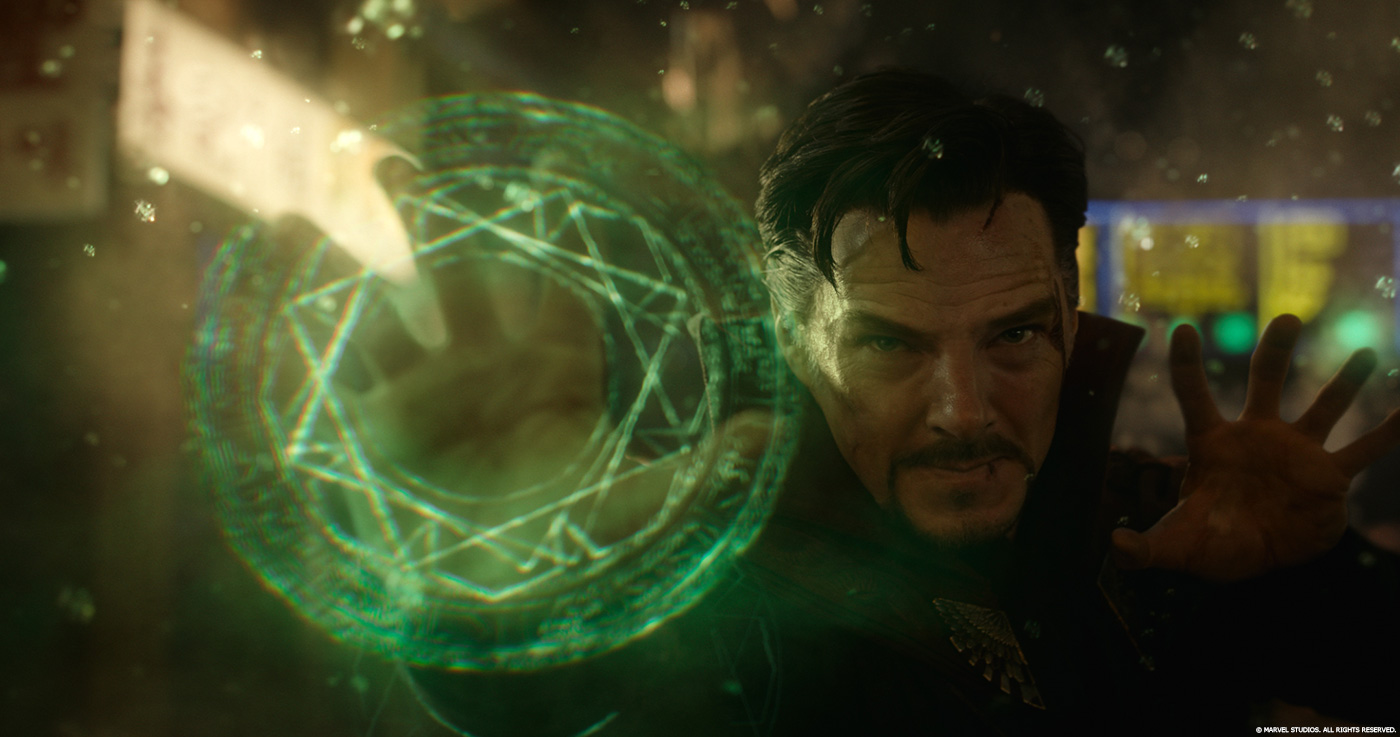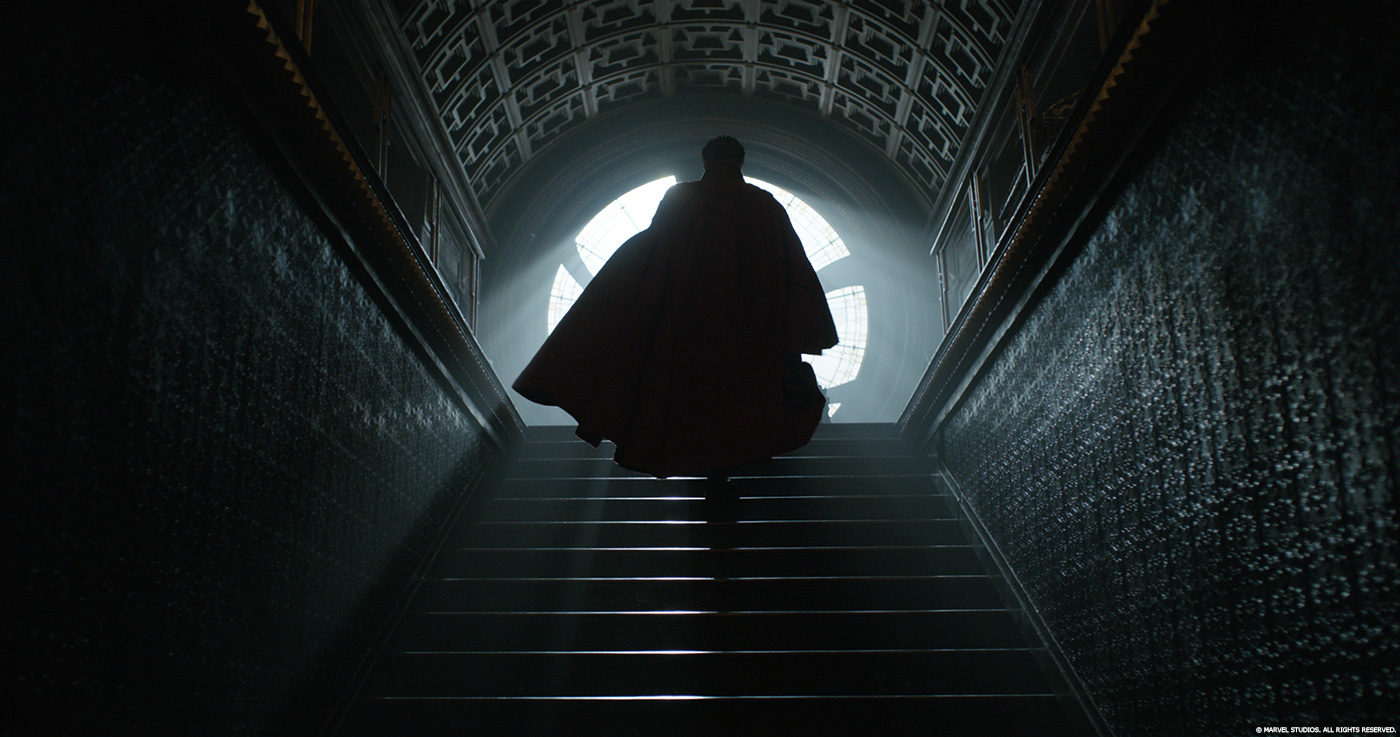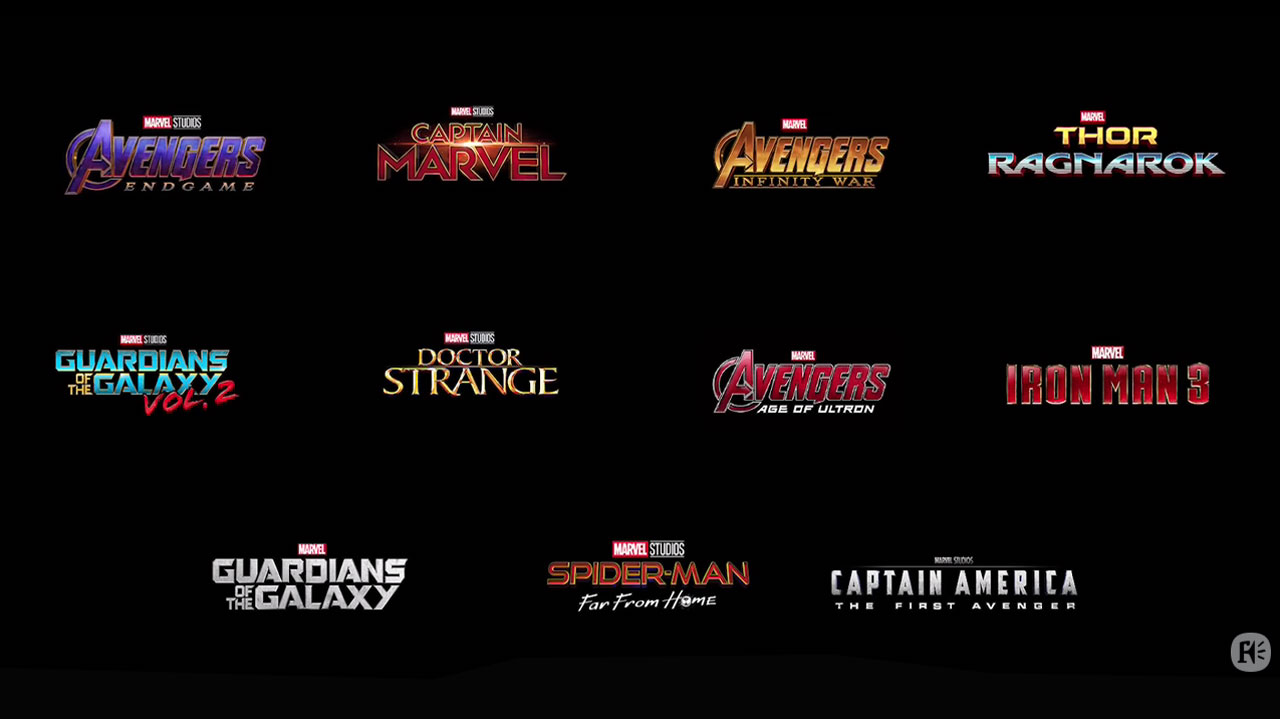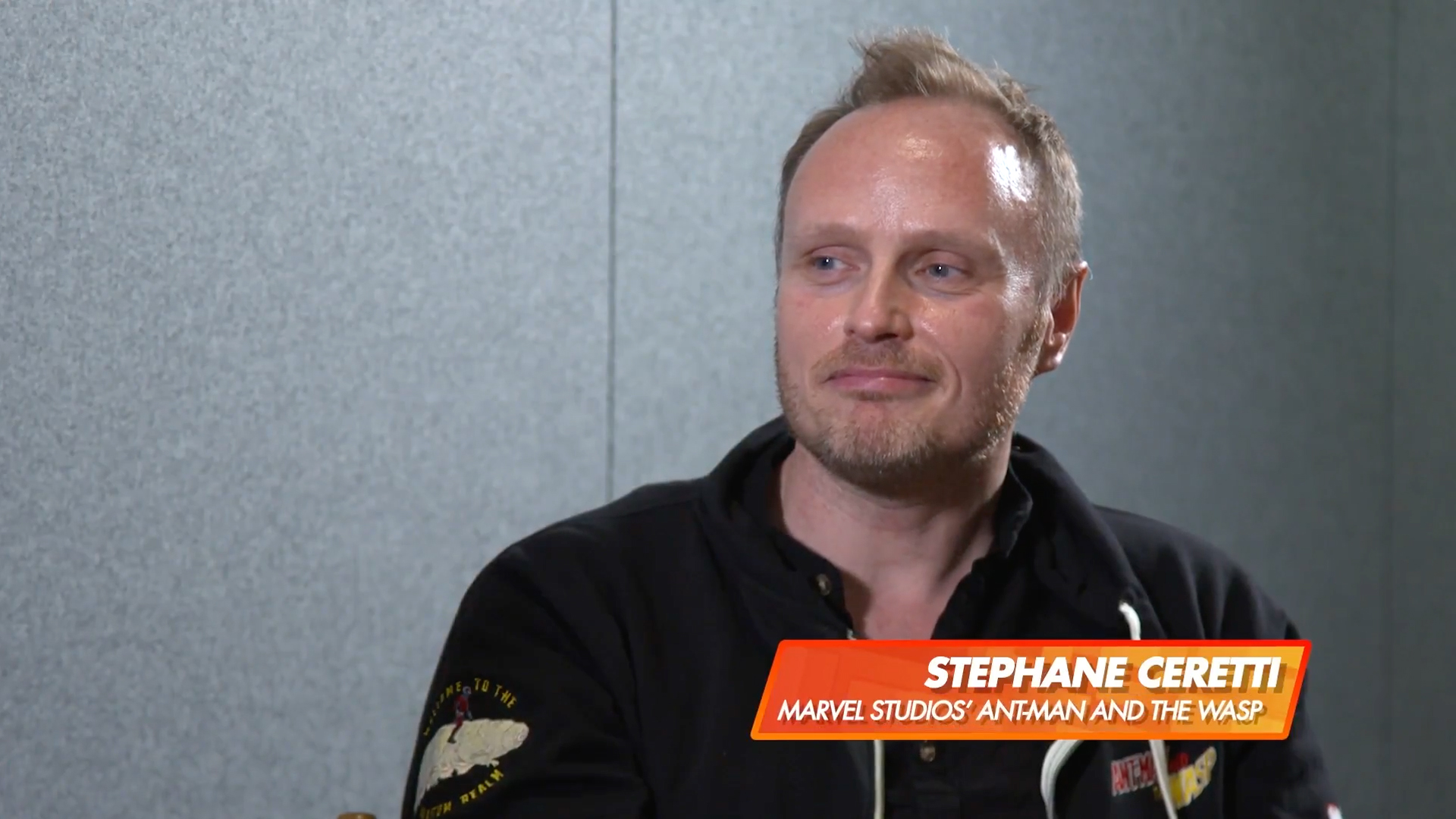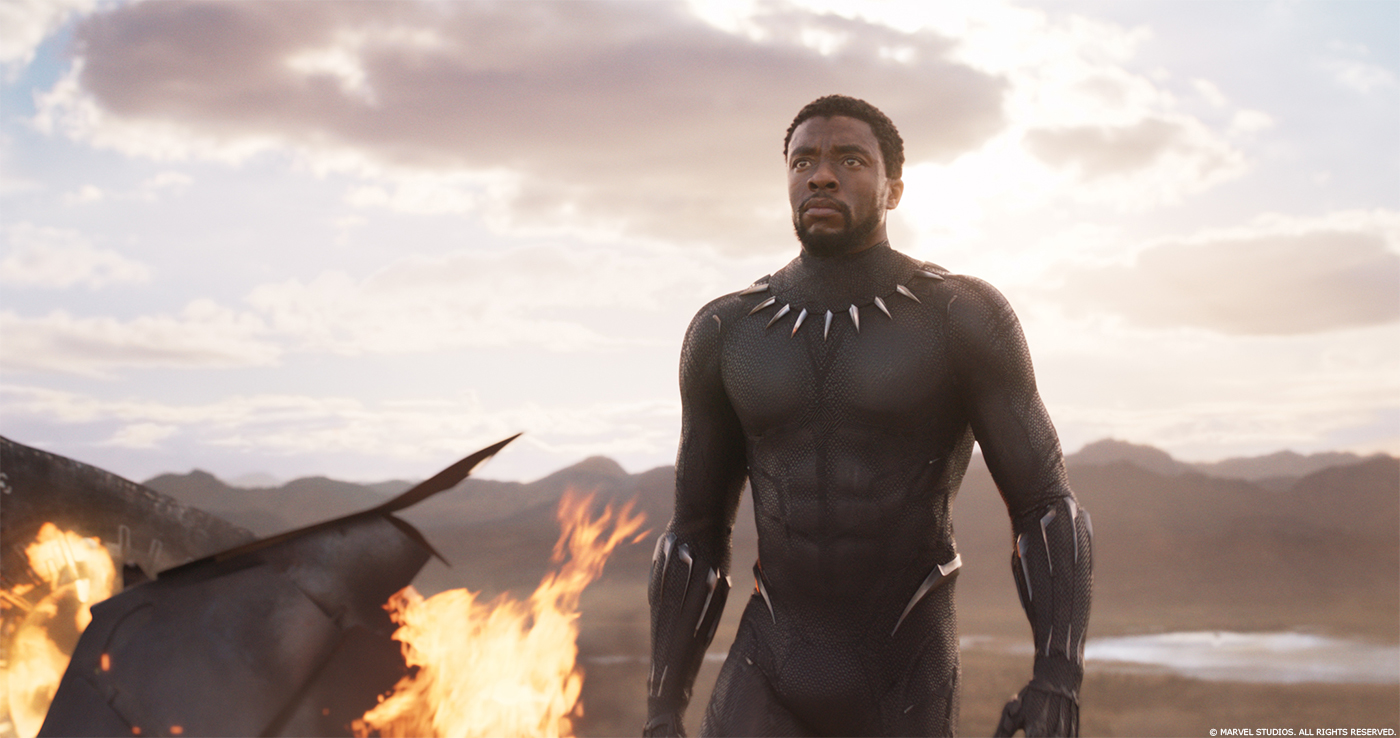Stephane Ceretti explained to us in details about his colossal work on GUARDIANS OF THE GALAXY in 2014. Today he talks about the many challenges encountered on DOCTOR STRANGE.
How did you got involved on this show?
As we were finishing GUARDIANS OF THE GALAXY with Susan Pickett my VFX producer, Victoria Alonso from Marvel talked to us about DOCTOR STRANGE and how it would take us to other dimensions rather than other galaxies. We were instantly thrilled and we got introduced us to Scott Derrickson the director of the film. The first meeting was very inspiring and exciting and we knew we were going to work onto something very special again!
How was this first collaboration with director Scott Derrickson?
It was very exciting. Scott is a very meticulous and visually savvy director. At every stage of the production and post production we communicated constantly to establish the universe we were about to create and his fresh approach open magic. He is a very inclusive director and always opened to suggestions and ideas that he then filters through his own experiences and approach of the script. The fact that he was also one of the script writers of the film makes it much more efficient because he knows the movie inside out and can answer or discuss about every single aspect of the film from a VFX point of view.
What was his approach and expectations about the visual effects?
There was 2 mains goals for the VFX. First one was to use Visual effects in a usual way. His take on the film was that at the end of it, nothing is actually destroyed, almost nobody died. He always said that he wanted to use the same VFX that have been used in so many blockbusters to destroy cities and kill thousands of people to do exactly the opposite. I think that was a very clever twist on the all blockbuster movie genre as well as a very clever use of our tools.
His other mandate was to make magic relatable. He wanted magic to be made of every day objects or phenomenon, something that the audience knows texturally and visually, but that we have behave in magical way. The portals are made of sparks that look real and physical and interact with the world in usual ways, but the way they form and what they do is surnatural. We applied the same principal to buildings, the time reversal sequence with the apple and all the Mandala and what we called the Eldritch magic.
How did you organize the work with VFX Producer Susan Pickett?
This is my second film with Susan and a lot of our crew from GUARDIANS came back in London and Los Angeles. We strategize everything together, breakdowns, bids, shooting methodology, who will be our previs supervisor and which vendors we are going to use for which sequences. We have to work very close together and Susan is the kind of producer that will support anything we need to get the movie done as long as it makes sense. I think we make a good team together. She’s just awesome.
Can you describe one of your typical day during the pre-prod, on-set and then during the post?
In pre-prod we had multiple phases, from the early days where it was mostly about breaking down the film and discussing the requirements for the film with Scott and the Marvel creative execs. Then we go into a portion of the pre-prod that is mostly about previs and bidding. And as we moved to London it was more about methodology meeting and working out the many technical challenges we would have shooting the film.
During production days are pretty long as shoot days were very dense with a lot of vfx sequences to shoot and supervise. And additional meetings after wrap to prepare for all the upcoming sequences as previs were updated and refined.
Once in post production it’s more classic days with lots of cineSync, studios review, editorial meetings and postvis meetings. A lot of attention is given to all the marketing requests like trailers, Comic-Con and other events where previews of the movie are shown. Towards the end we get more involved into the finishing of the films with a lot of DI sessions for all the different versions of the film we are delivering (2D, 3D, EDR, IMAX, Home Video).
Strange have an impressive car crash. Can you tell us more about the filming of the shots inside his car?
We had a cut off version of the car where Benedict was seating and it was on rail so we could get the impact of the crash. Also Paul Courbold and his team have built a special rig for the camera to move super fast as we were shooting with a phantom flex at 1000 fps. Method Studios Vancouver finished the car interior in CG, simulated the destruction of the dashboard and all the glass and water debris floating inside the car as well as the view outside the window. Benedict did a tremendous job acting the effect of the impact. The shot is quite striking in the middle of that high pace and high impact sequence.
The movie is playing with different dimensions and gravity. That would have been a huge challenge to prepare these shots. Can you tell us more about it?
It was a huge concerted effort between Scott, Charlie Wood the production designer, Faraz Hameed our previs supervisor and myself to come up with the looks of these dimensions. We also hired some of the most creative vendors like Luma Pictures and Method as well as ILM and Framestore and their input throughout the process has been phenomenal. I think we nurtured a creative environment where everybody, from the top of the studio to the VFX artists in the facilities could come up with ideas and make the movie better at each step of the process. Everybody was so excited.
For the gravity defying sequences we used combinations of wire work, partial body replacement, full digital double, tumbling sets, and CG sets as well… We try to mix the techniques so the mind can never settle on a particular type of effect… it allows for the illusion to last longer and make the people embrace it rather than question it.
The previzualisation plays a pivotal role for the shooting. How did you work with director Scott Derrickson and The Third Flood?
We started previs very early in the process as most of our sequences needed a level of screen dynamism that storyboards alone where not giving up. Scott and myself were very involved with our previs team. We also had the change to get Wyatt Smith out editor to join before the shoot to help with the previs editing. It was a huge factor for us in terms of nailing down the main shots so we could technically achieve them during the shoot.
The overall thinking behind the previs process was to follow the directions of Scott precisely, but also to try and « plus » it all the time. We never settle and always try to bring new ideas to the table to enhance the sequences. Sometimes ideas are too crazy and don’t fit the story point, but we want everybody to collaborate and bring their stone to build the edifice.
From a VFX point of view some shots gave me nightmares where I saw them in previs, but we always have to dig down into the specifics and figure out ways to achieve the effect. There was a lot of shots or even sequences we came up with where I was super excited and super worried at the same time. It was a challenge but we figured everything out and were prepared to shoot all the required elements. We had incredible support from all the departments and production to execute Scott’s vision of the film.
Doctor Strange is full of magic and dimensions. How did you work with the art department?
On a film like this one it has to be a perfect symbiosis between the VFX department and the art department… we are so linked by the hip, because when they finish we take their baton and keep running with it. I have done many films before with Charlie Wood who actually used to work in the VFX world… he understands more than anyone our needs. He is also the sweetest person and one of the most talented artist I have ever had the chance to work with. It helps us tremendously when this relationship works to that level.
Can you tell us more about the creation of the various magic?
Eldritch magic is the magic the sorcerers from Kamar Taj are using. Mostly based on light painting photography. Scott always wanted us to create magic that should use mundane everyday phenomenon like sparks and make them act in very unusual ways. This is what we did with the portals and mandalas and Eldritch whips and shield. The design of the mandala and rune shield was inspired by the original comics. We made sure all our sparks would follow perfect simulations and details so the audience could completely relate to them as being real.
Same attention was put into the bending building and making them photoreal but act in very unusual ways. We created also and effect that we called Mandlebrotting. Based on the 3D Fractal created by Benoit Mandelbrot, a french mathematician. Scott loved some of the videos that I showed him and found them very organic and mathematical at the same time. We used these in the London, cathedral, NY sanctum scene and NY chase. The idea was that as Zealots bend space the matter expands and grows in such a way that it gets broken and stretched using these mandelbrot patterns. It created something quite original and fresh. The biggest challenge was being able to texture and animate these 3D fractals in totally controllable ways. All our main vendors had to deal with this at different levels and match to each others which was a bit of a challenge as well in the time we had to create the effects.
How did you help the actors with their magic?
We showed them a lot of concepts, some early animated R&D tests we had done with vendors. Also for some of the fights they had LED string whips and we used a lot of interactive lights too. Previs was a key tool that was used to explain and define what we were doing so that at each instant they would know what is happening and how to react. It’s essential the actors get that level of knowledge of what will be done in post so we insure their acting support the illusion we are trying to create.
Can you tell us more about the challenge to visualize the Multiverse?
I suppose you are mostly talking about the Magic Mystery Tour sequence. It was a huge challenge. Initially the sequence was 7 minutes long and we were visiting more than 16 constantly evolving environments. I work in conjunction with Charlie Wood and his team of concept artists to create a huge amount of designs for each of these worlds. Charlie really created a template for all these worlds, trying to make sense of what the Ancient One is trying to show to Stephen Strange as he is travelling through all these dimensions. I also edited a small sequence of found material that we could refer to for screen dynamism and overall tempo. We discovered that we really had to have strange be an integral part of this journey and that the audience should experience it through him. Our previs team took all these on board and working with Scott and his storyboards as well as all the concepts and animated references we had gathered, we assembled a full animatic of the sequence. Wyatt our editor put it together with music and sounds.
This previs was used as a technical document for our shoot. Chris Shaw our additional supervisor was in charge of breaking down the shots and sort out which one would need special rigs and motion control. We came up with a motion base rig linked to a motion control camera system that we used to shoot Benedict’s motion and match the previs. A huge lighting rig put in place by Ben Davis and his team was used to project lights and colors onto Benedict’s face. After 2 weeks of rehearsal and setup, 3 days were spent with Benedict to capture all the required elements.
In the meantime Method LA and Vancouver started building all the required environments. They had to be dynamic and constantly evolving, colorful, dangerous, photo real but completely alien! Also a very high quality digital double of Strange had to be created either for take overs or full digit double work. We end up really close to a full digital Benedict Face in the key moment of the hands cavern and Strange falling into his own eye. Method did an amazing job with this. The result is a 2:30 minutes long sequence that never stops and goes through about 8 different environments. It’s like a little film within the film.
Some Multiverse shots have references to 2001. Can you tell us more about it and also about the other references?
Indeed, we’re all big fans of 2001 and when it comes to psychedelic colors and space travel there is no better reference than this. We tried to pay homage to the master!
What was the main references and indications for the re-shaping of the reality?
We obviously looked at INCEPTION, but our main inspiration was MC Escher, lots of optical illusions we found in photographic references and paintings, a video game called Monument Valley was also something we played a lot with in preproduction… It’s a very cleverly designed game!
One other complicated effects to design is the Astral projection. How did you handle this effects?
It was a combination of wire work, green screen and part/full digital double work. Framestore handled all these shots. They had to create a very high details version of Strange, The Ancient One and Strong Zealots to create the animation for the various sequences. The effect itself was a big challenge because we started with something a little bit to strong and effec-sy but we backed down and went for an effect that was protecting the performance of our incredible actors. Especially since we had a big dialogue scene on the balcony between Strange and The Ancient One. We put a lot of emphasis in the animation of the character and their flight patterns during the astral fight, the amount of interaction with the real world etc…. We found out that what would make the effect work was more a story and animation driven approach rather than having the effect take over the story.
Can you tell us more about the famous Cloak of Levitation?
The cloak was created by Alex Byrne, the costume designer of the film, based on concepts by the vizdev department at Marvel. It was a beautiful and elaborate piece of cloth. Most of the time Benedict is wearing a real cloak, but as soon as the cloak is active we had to resort to a CG version of it. We have scanned and textured it at a very high resolution so we could have a perfect match and fidelity between the real cloak and its CG counterpart. All our vendors had to use a digital cloak one way or another but Framestore was in charge of the scenes where we the cloak really was demonstrating its character in animation. We felt like they were the best vendor to create this « character » as we worked with them on Rocket and Groot on GUARDIANS OF THE GALAXY. We liked to compare the cloak to the magic carpet in ALADDIN. And the story arc of the relationship between Strange and Cloak was very funny to execute.
The final sequence in Hong Kong involved changes of time. Can you explain in details about this great sequence?
We went to HK to scout possible shooting locations but due to the complexity of the scene we had to build a 800 feet version of the street in the backlot at Longcross Studios, in London. ILM and the art department went back to HK to texture and select reference shops and buildings to build the street. The entire sequence was prevised so we could follow a very precise shooting plan and methodology for each and every shot. It was essential to know what level of destruction and what moving elements our actors and the BG crowd would be interacting with at each moment of the sequence.
The big challenge of the scene was the amount of destruction, but also the fact that the scene runs backward in time. with our heroes going forward in time. The fight then becomes a fight between our heroes and the Zealots, but also a fight against the environment and how unpredictable it is. We shot multiple passes with motion control running at different speeds. It was a very time consuming process and overall the Hong Kong sequence was shot over 23 nights in London.
Once in post production, ILM was in charge of the sequence. It was quite a very challenging one, even for ILM, as the amount of destruction and the fact that the action was constantly surrounding and interacting with our characters made it extremely tricky to accomplish.
Which sequence was the most complicated to create and why?
Every sequence had its share of complications both on a technical and design level. I would say that NY and Hong Kong were the most logistically complex, The Magic Mystery Tour was challenging from a design point of view as well as the Dark Dimension. The Astral projection sequences were also quite tricky to pull off for multiple reasons, one of them being the amount of digital doubles we had to use and the constant mixture of green screen elements and CG characters.
How did you choose your various vendors?
It’s a bit like a casting. You go for the guys you feel are gonna be the best at. Some are better at big heavy simulation sequences, others are better at smaller R&D driven FX. You need to strike the right balance with your vendors. We had 4 initial vendors and some extra vendors joined in post to help with extra shots.
Can you tell us more about your collaboration with their respective VFX Supervisors and teams?
We do most of our reviews using cineSync. I also try to get the vendors on set as much as possible so they interact with the crew and the director soon in the process. I try to have an open door policy with everybody so we can discuss anything at any time and come up with ideas and solutions to the many problems you encounter on this kind of film.
What was the main challenge on the show and how did you achieve it?
The short post time and the quantity and variety of the effects we had to R&D in that short period of time. Knowing that we had some additional photography in August that required some pretty heavy VFX work as well was a bit of a challenge.
But the biggest challenge was to make sure our magic wouldn’t take over the film and make it difficult to follow… We try to service the story and it takes a bit of finesse and balance and working closely with the directors, editors and producer to achieve this.
Was there a shot or a sequence that prevented you from sleep?
All of them!
What do you keep from this experience?
That fear is not an option.
How long have you worked on this film?
2 years.
How many shots have you done?
1450 VFX shots in the film.
What was the size of your team?
Well, if you count all the vendors I am sure we are around a thousand artists.
You did a cameo in GUARDIANS OF THE GALAXY. Any chance to see you in DOCTOR STRANGE?
Yes ! You can see me in NY, inside the mirror dimension.
What is your next project?
Still To Be Announced.
A big thanks for your time.
IMAX® Presents: Visual Effects Supervisor Stephane Ceretti
© Vincent Frei – The Art of VFX – 2016


